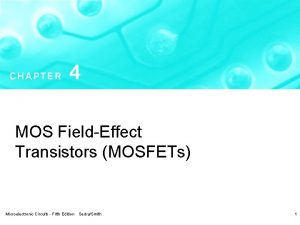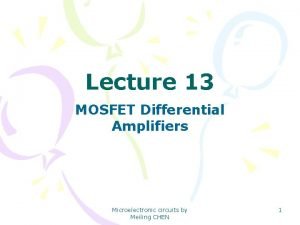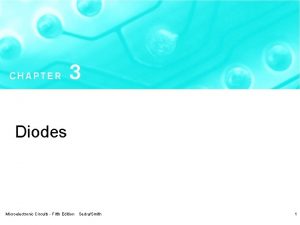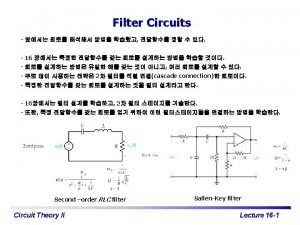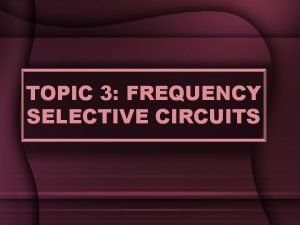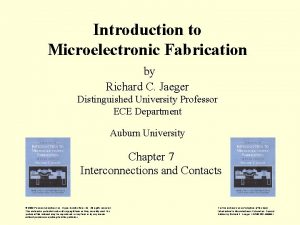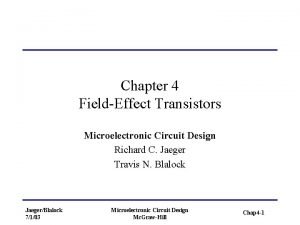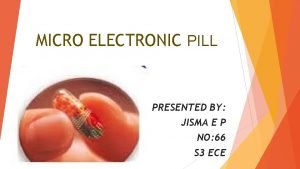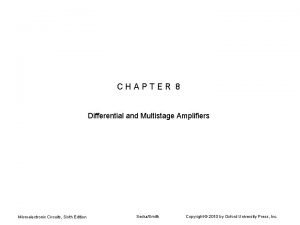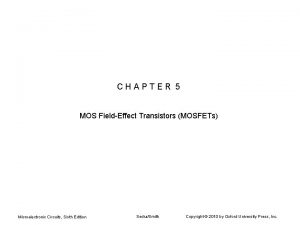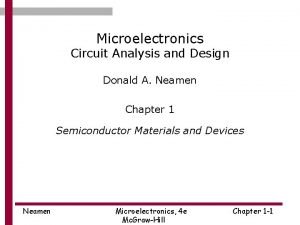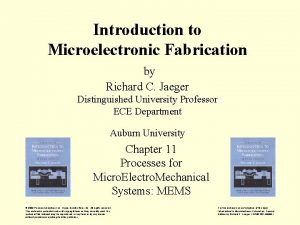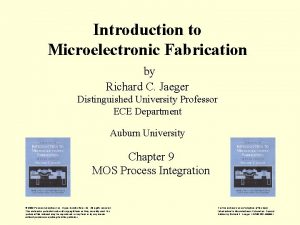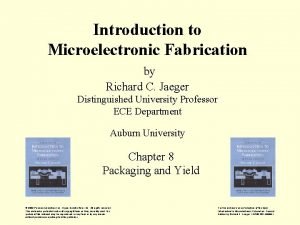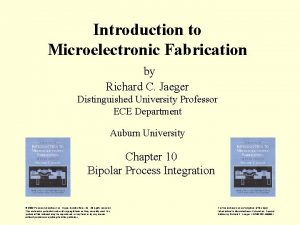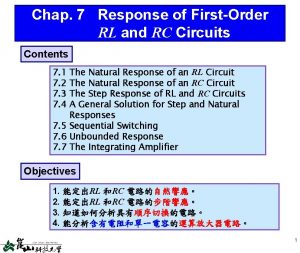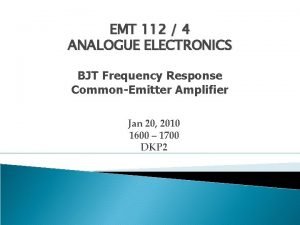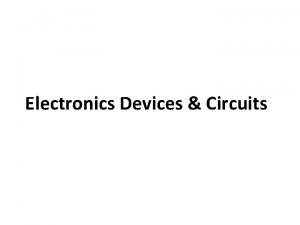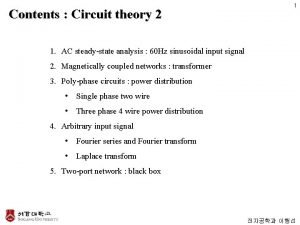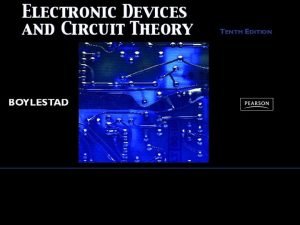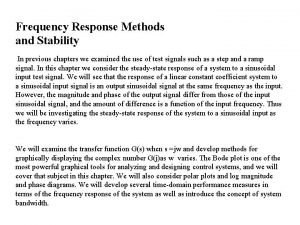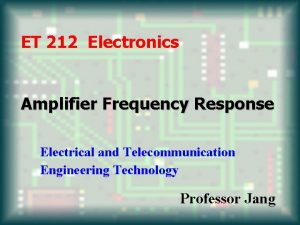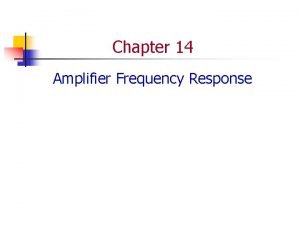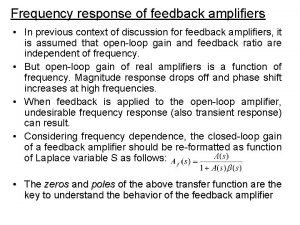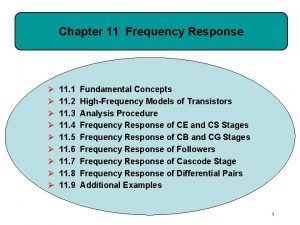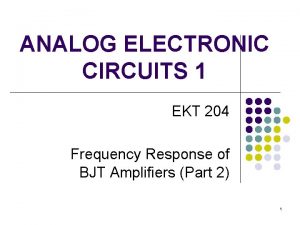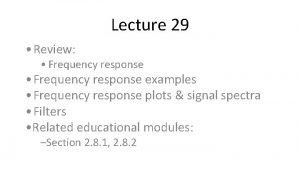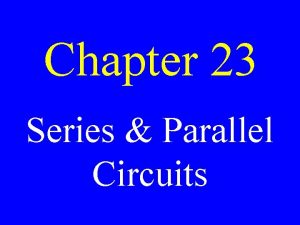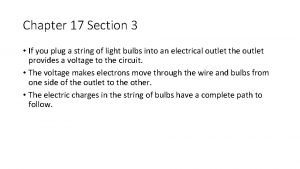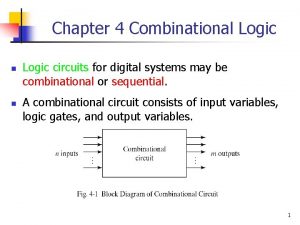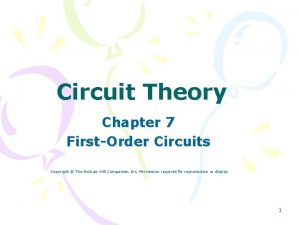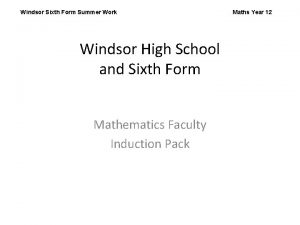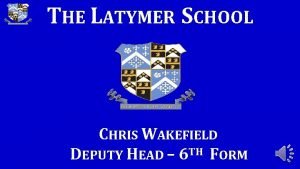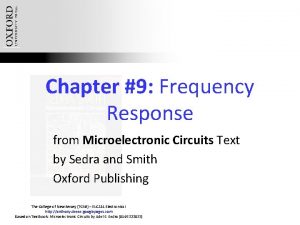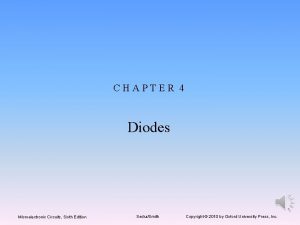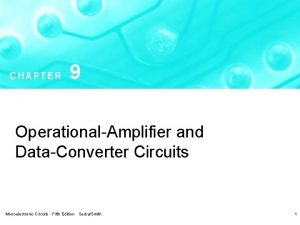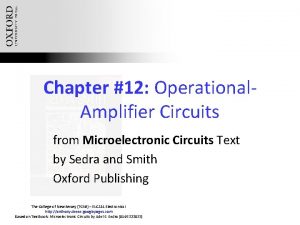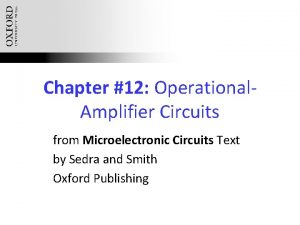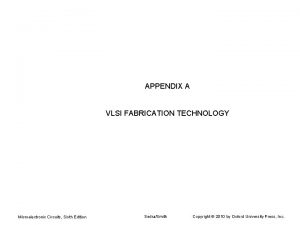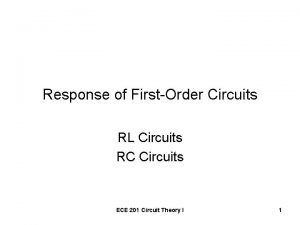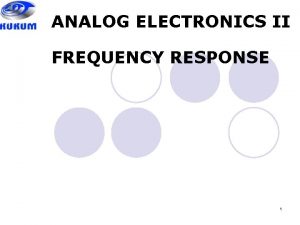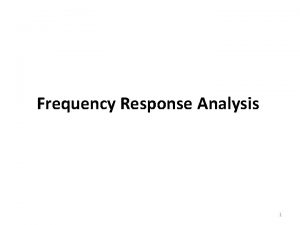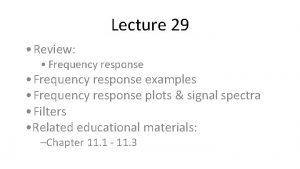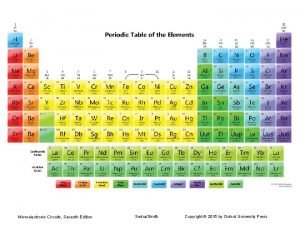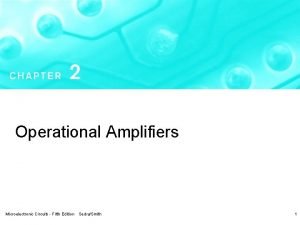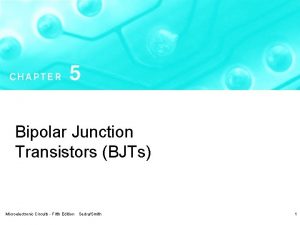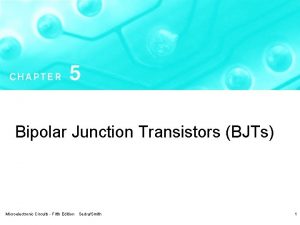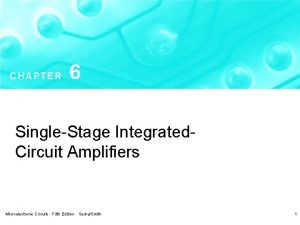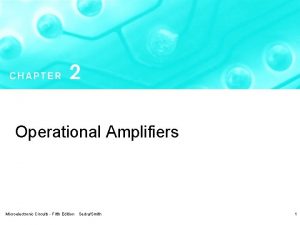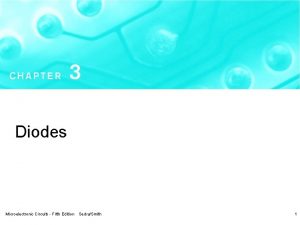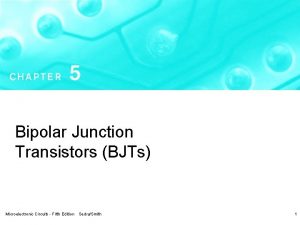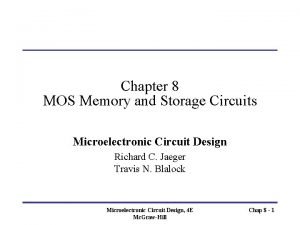CHAPTER 9 Frequency Response Microelectronic Circuits Sixth Edition












































































- Slides: 76

CHAPTER 9 Frequency Response Microelectronic Circuits, Sixth Edition Sedra/Smith Copyright © 2010 by Oxford University Press, Inc.

Figure 9. 1 Sketch of the magnitude of the gain of a discrete-circuit BJT or MOS amplifier versus frequency. The graph delineates the three frequency bands relevant to frequency-response determination. Microelectronic Circuits, Sixth Edition Sedra/Smith Copyright © 2010 by Oxford University Press, Inc.

Figure 9. 2 (a) Capacitively coupled common-source amplifier. (b) Analysis of the CS amplifier to determine its low-frequency transfer function. For simplicity, ro is neglected. Microelectronic Circuits, Sixth Edition Sedra/Smith Copyright © 2010 by Oxford University Press, Inc.

Figure 9. 3 Sketch of the low-frequency magnitude response of a CS amplifier for which the three pole frequencies are sufficiently separated for their effects to appear distinct. Microelectronic Circuits, Sixth Edition Sedra/Smith Copyright © 2010 by Oxford University Press, Inc.

Figure 9. 4 (a) A capacitively coupled common-emitter amplifier. (b) The circuit prepared for small-signal analysis. Microelectronic Circuits, Sixth Edition Sedra/Smith Copyright © 2010 by Oxford University Press, Inc.

Figure 9. 5 Analysis of the low-frequency response of the CE amplifier of Fig. 9. 4: (a) the effect of CC 1 is determined with CE and CC 2 assumed to be acting as perfect short circuits; (b) the effect of CE is determined with CC 1 and CC 2 assumed to be acting as perfect short circuits; Microelectronic Circuits, Sixth Edition Sedra/Smith Copyright © 2010 by Oxford University Press, Inc.

Figure 9. 5 (continued ) (c) the effect of CC 2 is determined with CC 1 and CE assumed to be acting as perfect short circuits; (d) sketch of the low-frequency gain under the assumptions that CC 1, CE, and CC 2 do not interact and that their break (or pole) frequencies are widely separated. Microelectronic Circuits, Sixth Edition Sedra/Smith Copyright © 2010 by Oxford University Press, Inc.

Figure 9. 6 (a) High-frequency, equivalent-circuit model for the MOSFET. (b) The equivalent circuit for the case in which the source is connected to the substrate (body). (continued) Microelectronic Circuits, Sixth Edition Sedra/Smith Copyright © 2010 by Oxford University Press, Inc.

Figure 9. 6 (continued) (c) The equivalent-circuit model of (b) with Cdb neglected (to simplify analysis). Microelectronic Circuits, Sixth Edition Sedra/Smith Copyright © 2010 by Oxford University Press, Inc.

Figure 9. 7 Determining the short-circuit current gain Io / Ii. Microelectronic Circuits, Sixth Edition Sedra/Smith Copyright © 2010 by Oxford University Press, Inc.

Table 9. 1 The MOSFET High-Frequency Model Microelectronic Circuits, Sixth Edition Sedra/Smith Copyright © 2010 by Oxford University Press, Inc.

Microelectronic Circuits, Sixth Edition Sedra/Smith Copyright © 2010 by Oxford University Press, Inc.

Microelectronic Circuits, Sixth Edition Sedra/Smith Copyright © 2010 by Oxford University Press, Inc.

Microelectronic Circuits, Sixth Edition Sedra/Smith Copyright © 2010 by Oxford University Press, Inc.

Figure 9. 11 Variation of f. T with IC. Microelectronic Circuits, Sixth Edition Sedra/Smith Copyright © 2010 by Oxford University Press, Inc.

Table 9. 2 The BJT High-Frequency Model Microelectronic Circuits, Sixth Edition Sedra/Smith Copyright © 2010 by Oxford University Press, Inc.

Figure 9. 12 Frequency response of a direct-coupled (dc) amplifier. Observe that the gain does not fall off at low frequencies, and the midband gain AM extends down to zero frequency. Microelectronic Circuits, Sixth Edition Sedra/Smith Copyright © 2010 by Oxford University Press, Inc.

Figure 9. 13 Determining the high-frequency response of the CS amplifier: (a) equivalent circuit; (b) the circuit of (a) simplified at the input and the output; (Continued) Microelectronic Circuits, Sixth Edition Sedra/Smith Copyright © 2010 by Oxford University Press, Inc.

Figure 9. 13 (Continued) (c) the equivalent circuit with Cgd replaced at the input side with the equivalent capacitance Ceq; (d) the frequency response plot, which is that of a low-pass, single-time-constant circuit. Microelectronic Circuits, Sixth Edition Sedra/Smith Copyright © 2010 by Oxford University Press, Inc.

Figure 9. 14 Determining the high-frequency response of the CE amplifier: (a) equivalent circuit; (b) the circuit of (a) simplified at both the input side and the output side; (continued) Microelectronic Circuits, Sixth Edition Sedra/Smith Copyright © 2010 by Oxford University Press, Inc.

Microelectronic Circuits, Sixth Edition Sedra/Smith Copyright © 2010 by Oxford University Press, Inc.

Figure 9. 15 Normalized high-frequency response of the amplifier in Example 9. 5. Microelectronic Circuits, Sixth Edition Sedra/Smith Copyright © 2010 by Oxford University Press, Inc.

Figure 9. 16 Circuits for Example 9. 6: (a) high-frequency equivalent circuit of a MOSFET amplifier; (b) the equivalent circuit at midband frequencies; (continued) Microelectronic Circuits, Sixth Edition Sedra/Smith Copyright © 2010 by Oxford University Press, Inc.

Figure 9. 16 (continued) (c) circuit for determining the resistance seen by Cgs; (d) circuit for determining the resistance seen by Cgd. Microelectronic Circuits, Sixth Edition Sedra/Smith Copyright © 2010 by Oxford University Press, Inc.

Figure 9. 17 The Miller equivalent circuit. Microelectronic Circuits, Sixth Edition Sedra/Smith Copyright © 2010 by Oxford University Press, Inc.

Figure 9. 18 Circuits for Example 9. 7. (continued) Microelectronic Circuits, Sixth Edition Sedra/Smith Copyright © 2010 by Oxford University Press, Inc.

Figure 9. 18 (continued) Microelectronic Circuits, Sixth Edition Sedra/Smith Copyright © 2010 by Oxford University Press, Inc.

Figure E 9. 15 Microelectronic Circuits, Sixth Edition Sedra/Smith Copyright © 2010 by Oxford University Press, Inc.

Figure 9. 19 Generalized high-frequency equivalent circuit for the CS amplifier. Microelectronic Circuits, Sixth Edition Sedra/Smith Copyright © 2010 by Oxford University Press, Inc.

Figure 9. 20 The high-frequency equivalent circuit model of the CS amplifier after the application of Miller’s theorem to replace the bridging capacitor Cgd by two capacitors: C 1 = Cgd(1 -K) and C 2 = Cgd(1 -1/K), where K = V 0/Vgs. Microelectronic Circuits, Sixth Edition Sedra/Smith Copyright © 2010 by Oxford University Press, Inc.

Figure 9. 21 Application of the open-circuit time-constants method to the CS equivalent circuit of Fig. 9. 19. Microelectronic Circuits, Sixth Edition Sedra/Smith Copyright © 2010 by Oxford University Press, Inc.

Figure 9. 22 Analysis of the CS high-frequency equivalent circuit. Microelectronic Circuits, Sixth Edition Sedra/Smith Copyright © 2010 by Oxford University Press, Inc.

Figure 9. 23 The CS circuit at s = s. Z. The output voltage Vo = 0, enabling us to determine s. Z from a node equation at D. Microelectronic Circuits, Sixth Edition Sedra/Smith Copyright © 2010 by Oxford University Press, Inc.

Figure 9. 24 (a) High-frequency equivalent circuit of the common-emitter amplifier. (b) Equivalent circuit obtained after Thévenin theorem has been employed to simplify the resistive circuit at the input. Microelectronic Circuits, Sixth Edition Sedra/Smith Copyright © 2010 by Oxford University Press, Inc.

Figure 9. 25 (a) High-frequency equivalent circuit of a CS amplifier fed with a signal source having a very low (effectively zero) resistance. (b) The circuit with Vsig reduced to zero. (continued) Microelectronic Circuits, Sixth Edition Sedra/Smith Copyright © 2010 by Oxford University Press, Inc.

Figure 9. 25 (continued) (c) Bode plot for the gain of the circuit in (a). Microelectronic Circuits, Sixth Edition Sedra/Smith Copyright © 2010 by Oxford University Press, Inc.

Figure 9. 26 (a) The common-gate amplifier with the transistor internal capacitances shown. A load capacitance CL is also included. (b) Equivalent circuit for the case in which ro is neglected. Microelectronic Circuits, Sixth Edition Sedra/Smith Copyright © 2010 by Oxford University Press, Inc.

Figure 9. 27 Circuits for determining Rgs and Rgd. Microelectronic Circuits, Sixth Edition Sedra/Smith Copyright © 2010 by Oxford University Press, Inc.

Figure 9. 28 The CG amplifier circuit at midband. Microelectronic Circuits, Sixth Edition Sedra/Smith Copyright © 2010 by Oxford University Press, Inc.

Figure 9. 29 The cascode circuit with the various transistor capacitances indicated. Microelectronic Circuits, Sixth Edition Sedra/Smith Copyright © 2010 by Oxford University Press, Inc.

Figure 9. 30 Effect of cascoding on gain and bandwidth in the case Rsig = 0. Cascoding can increase the dc gain by the factor A 0 while keeping the unity-gain frequency constant. Note that to achieve the high gain, the load resistance must be increased by the factor. A 0. Microelectronic Circuits, Sixth Edition Sedra/Smith Copyright © 2010 by Oxford University Press, Inc.

Microelectronic Circuits, Sixth Edition Sedra/Smith Copyright © 2010 by Oxford University Press, Inc.

Figure 9. 32 Analysis of the high-frequency response of the source follower: (a) equivalent circuit; (b) simplified equivalent circuit; (c) determining the resistance Rgs seen by Cgs. Microelectronic Circuits, Sixth Edition Sedra/Smith Copyright © 2010 by Oxford University Press, Inc.

Figure 9. 33 (a) Emitter follower. (b) High-frequency equivalent circuit. (c) Simplified equivalent circuit. Microelectronic Circuits, Sixth Edition Sedra/Smith Copyright © 2010 by Oxford University Press, Inc.

Figure 9. 34 (a) A resistively loaded MOS differential pair; the transistor supplying the bias current is explicitly shown. It is assumed that the total impedance between node S and ground, ZSS, consists of a resistance RSS in parallel with a capacitance CSS. (b) Differential half-circuit. (c) Common-mode half-circuit. Microelectronic Circuits, Sixth Edition Sedra/Smith Copyright © 2010 by Oxford University Press, Inc.

Figure 9. 35 Variation of (a) common-mode gain, (b) differential gain, and (c) common-mode rejection ratio with frequency. Microelectronic Circuits, Sixth Edition Sedra/Smith Copyright © 2010 by Oxford University Press, Inc.

Figure 9. 36 The second stage in a differential amplifier, which is relied on to suppress high-frequency noise injected by the power supply of the first stage, and therefore must maintain a high CMRR at higher frequencies. Microelectronic Circuits, Sixth Edition Sedra/Smith Copyright © 2010 by Oxford University Press, Inc.

Figure 9. 37 (a) Frequency–response analysis of the active-loaded MOS differential amplifier. (b) The overall transconductance Gm as a function of frequency. Microelectronic Circuits, Sixth Edition Sedra/Smith Copyright © 2010 by Oxford University Press, Inc.

Figure 9. 38 (a) The CS amplifier circuit, with a source resistance Rs. (b) Equivalent-circuit representation of the amplifier output. (c) The circuit prepared for frequency-response analysis. (d) Determining the resistance Rgd seen by the capacitance Cgd. Microelectronic Circuits, Sixth Edition Sedra/Smith Copyright © 2010 by Oxford University Press, Inc.

Figure 9. 39 (a) CD–CS amplifier. (b) CC–CE amplifier. (c) CD–CE amplifier. Microelectronic Circuits, Sixth Edition Sedra/Smith Copyright © 2010 by Oxford University Press, Inc.

Figure 9. 40 Circuits for Example 9. 14: (a) the CC–CE circuit prepared for low-frequency, small-signal analysis; (b) the circuit at high frequencies, with Vsig set to zero to enable determination of the open-circuit time constants; (c) a CE amplifier for comparison. Microelectronic Circuits, Sixth Edition Sedra/Smith Copyright © 2010 by Oxford University Press, Inc.

Figure 9. 41 (a) A CC–CB amplifier. (b) Another version of the CC–CB circuit with Q 2 implemented using a pnp transistor. (c) The MOSFET version of the circuit in (a). Microelectronic Circuits, Sixth Edition Sedra/Smith Copyright © 2010 by Oxford University Press, Inc.

Microelectronic Circuits, Sixth Edition Sedra/Smith Copyright © 2010 by Oxford University Press, Inc.

Figure 9. 43 Two-stage CMOS op-amp configuration. Microelectronic Circuits, Sixth Edition Sedra/Smith Copyright © 2010 by Oxford University Press, Inc.

Figure 9. 44 Equivalent circuit of the op amp in Fig. 9. 43. Microelectronic Circuits, Sixth Edition Sedra/Smith Copyright © 2010 by Oxford University Press, Inc.

Figure 9. 45 (a) Approximate equivalent circuit for determining the high-frequency response of the op amp of Fig. 8. 43. (b) Equivalent circuit of the interface between the output of Q 2 and the input of Q 5. Microelectronic Circuits, Sixth Edition Sedra/Smith Copyright © 2010 by Oxford University Press, Inc.

Figure P 9. 1 Microelectronic Circuits, Sixth Edition Sedra/Smith Copyright © 2010 by Oxford University Press, Inc.

Figure P 9. 3 Microelectronic Circuits, Sixth Edition Sedra/Smith Copyright © 2010 by Oxford University Press, Inc.

Figure P 9. 11 Microelectronic Circuits, Sixth Edition Sedra/Smith Copyright © 2010 by Oxford University Press, Inc.

Figure P 9. 14 Microelectronic Circuits, Sixth Edition Sedra/Smith Copyright © 2010 by Oxford University Press, Inc.

Figure P 9. 15 Microelectronic Circuits, Sixth Edition Sedra/Smith Copyright © 2010 by Oxford University Press, Inc.

Figure P 9. 34 Microelectronic Circuits, Sixth Edition Sedra/Smith Copyright © 2010 by Oxford University Press, Inc.

Figure P 9. 41 Microelectronic Circuits, Sixth Edition Sedra/Smith Copyright © 2010 by Oxford University Press, Inc.

Figure P 9. 42 Microelectronic Circuits, Sixth Edition Sedra/Smith Copyright © 2010 by Oxford University Press, Inc.

Figure P 9. 52 Microelectronic Circuits, Sixth Edition Sedra/Smith Copyright © 2010 by Oxford University Press, Inc.

Figure P 9. 59 Microelectronic Circuits, Sixth Edition Sedra/Smith Copyright © 2010 by Oxford University Press, Inc.

Figure P 9. 67 Microelectronic Circuits, Sixth Edition Sedra/Smith Copyright © 2010 by Oxford University Press, Inc.

Figure P 9. 69 Microelectronic Circuits, Sixth Edition Sedra/Smith Copyright © 2010 by Oxford University Press, Inc.

Figure P 9. 70 Microelectronic Circuits, Sixth Edition Sedra/Smith Copyright © 2010 by Oxford University Press, Inc.

Figure P 9. 89 Microelectronic Circuits, Sixth Edition Sedra/Smith Copyright © 2010 by Oxford University Press, Inc.

Figure P 9. 102 Microelectronic Circuits, Sixth Edition Sedra/Smith Copyright © 2010 by Oxford University Press, Inc.

Figure P 9. 103 Microelectronic Circuits, Sixth Edition Sedra/Smith Copyright © 2010 by Oxford University Press, Inc.

Figure P 9. 104 Microelectronic Circuits, Sixth Edition Sedra/Smith Copyright © 2010 by Oxford University Press, Inc.

Figure P 9. 105 Microelectronic Circuits, Sixth Edition Sedra/Smith Copyright © 2010 by Oxford University Press, Inc.

Figure P 9. 108 Microelectronic Circuits, Sixth Edition Sedra/Smith Copyright © 2010 by Oxford University Press, Inc.

Figure P 9. 112 Microelectronic Circuits, Sixth Edition Sedra/Smith Copyright © 2010 by Oxford University Press, Inc.
 Sedra smith
Sedra smith Mosfet differential amplifier gain
Mosfet differential amplifier gain Sedra
Sedra Peter piper picked
Peter piper picked The sixth sick sheik's sixth sheep's sick lyrics
The sixth sick sheik's sixth sheep's sick lyrics Advantages of parallel circuits over series circuit
Advantages of parallel circuits over series circuit Biochemistry sixth edition 2007 w.h. freeman and company
Biochemistry sixth edition 2007 w.h. freeman and company Computer architecture a quantitative approach sixth edition
Computer architecture a quantitative approach sixth edition Automotive technology sixth edition
Automotive technology sixth edition Automotive technology sixth edition
Automotive technology sixth edition Apa sixth edition
Apa sixth edition Computer architecture a quantitative approach sixth edition
Computer architecture a quantitative approach sixth edition Precalculus sixth edition
Precalculus sixth edition Rational people think at the margin
Rational people think at the margin Computer architecture a quantitative approach sixth edition
Computer architecture a quantitative approach sixth edition Butterworth bandpass filter
Butterworth bandpass filter Rl circuit transfer function
Rl circuit transfer function Frequency selective circuits
Frequency selective circuits Principles of electric circuits 10th edition answer key
Principles of electric circuits 10th edition answer key Microelectronic fabrication
Microelectronic fabrication Rit microelectronic engineering
Rit microelectronic engineering Jaeger microelectronic circuit design download
Jaeger microelectronic circuit design download Micro electronic pill research paper
Micro electronic pill research paper Microelectronic
Microelectronic Microelectronic
Microelectronic Microelectronics circuit analysis and design
Microelectronics circuit analysis and design Jaeger metal fabrication
Jaeger metal fabrication Introduction to microelectronic fabrication
Introduction to microelectronic fabrication Introduction to microelectronic fabrication jaeger 1990
Introduction to microelectronic fabrication jaeger 1990 Introduction to microelectronic fabrication jaeger 1990
Introduction to microelectronic fabrication jaeger 1990 Rc response
Rc response Lesson 31 categorical data in frequency tables
Lesson 31 categorical data in frequency tables Expected relative frequency
Expected relative frequency Constant phase difference
Constant phase difference Vmax=aw
Vmax=aw Frequency vs relative frequency
Frequency vs relative frequency Marginal frequency table
Marginal frequency table Joint and marginal relative frequencies
Joint and marginal relative frequencies Using mis (10th edition) 10th edition
Using mis (10th edition) 10th edition Using mis 10th edition
Using mis 10th edition Formula for cutoff frequency
Formula for cutoff frequency Multistage amplifier
Multistage amplifier Inductor frequency response
Inductor frequency response Electronic devices and circuit theory
Electronic devices and circuit theory Frequency response methods and stability
Frequency response methods and stability Frequency response curve of an amplifier
Frequency response curve of an amplifier Formula for cutoff frequency
Formula for cutoff frequency High frequency transistor amplifier
High frequency transistor amplifier Frequency response of feedback amplifier
Frequency response of feedback amplifier Source follower frequency response
Source follower frequency response Frequency response cbe
Frequency response cbe Frequency response of single delay line canceller
Frequency response of single delay line canceller Rl circuit frequency response
Rl circuit frequency response The sixth extinction chapter 3 summary
The sixth extinction chapter 3 summary Natural response and forced response
Natural response and forced response What is natural response
What is natural response A subsequent
A subsequent Fundamentals of electric circuits chapter 4 solutions
Fundamentals of electric circuits chapter 4 solutions Electric current
Electric current Chapter 35 electric circuits
Chapter 35 electric circuits Chapter 23 series and parallel circuits
Chapter 23 series and parallel circuits Chapter 20 electric circuits
Chapter 20 electric circuits Chapter 17 section 3 circuits answer key
Chapter 17 section 3 circuits answer key The circuit chapter 9
The circuit chapter 9 Fundamentals of electric circuits chapter 7 solutions
Fundamentals of electric circuits chapter 7 solutions Chapter 35 electric circuits answers
Chapter 35 electric circuits answers Ohm's law and electric power worksheet answers
Ohm's law and electric power worksheet answers Table of 32
Table of 32 Chapter 35 electric circuits
Chapter 35 electric circuits Chapter 7 first-order circuits
Chapter 7 first-order circuits Nuast school holidays
Nuast school holidays Windsor sixth form
Windsor sixth form Shenfield sixth form
Shenfield sixth form Sixth grade transition words
Sixth grade transition words Ninth commandment catholic
Ninth commandment catholic First circle of hell
First circle of hell Latymer sixth form
Latymer sixth form
